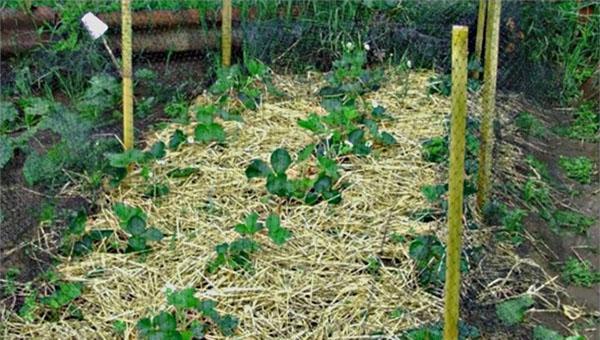How and when to mulch strawberries
 Mulching strawberries is the most important procedure for harvesting. Mulch retains moisture in the soil. Thanks to her, the berries will "pick up juice" faster. In addition, mulched beds can be watered less frequently, so the plant roots will not rot.
Mulching strawberries is the most important procedure for harvesting. Mulch retains moisture in the soil. Thanks to her, the berries will "pick up juice" faster. In addition, mulched beds can be watered less frequently, so the plant roots will not rot.
Due to an excess of moisture with heavy rainfall in the summer, the berries can rot. Mulch prevents rotting of garden strawberries and the development of fungal diseases. Any material can be used as a mulch layer. The most common mulching materials are:
- black agrofiber;
- sawdust with vermicompost;
- hay.
Each material has its own advantages and disadvantages. Let's consider each mulch in more detail.
Advantages and disadvantages of agrofibre
Mulching with agrofibre or black spunbond is the most common way to mulch strawberries. The advantage of such a mulching material is its dense structure.
Moisture condenses under such mulch, which favorably affects the seedlings during the period of active growth. In rainy weather, this mulch material keeps excess moisture out of the roots. garden strawberries.
Mulching the beds with humus
Humus or rotted cow dung mixed with sawdust is a good mulch and plant food. During watering, nutrients will be absorbed into the soil.
This material is well suited for summer mulching, but in rainy weather the mulch is saturated with moisture. Therefore, the roots of garden strawberries rot. In rainy weather, in beds with such mulch, the risk of fungal diseases increases.
Mulching with hay and grass
Using hay as mulch is a “golden mean” between agrofibre and organic natural fertilizers. Hay does not allow excess moisture to pass to the roots of plants, and rotting gives the plants nutrients.
However, this material also has its drawbacks. The fruits of garden strawberries, with such mulching, can be affected by fungal diseases.
In addition, with such mulching, weeds will appear in the garden. Therefore, every two weeks it is necessary to weed the beds.